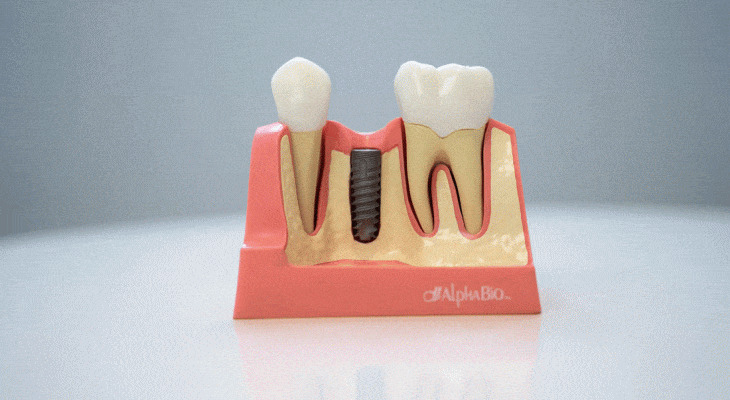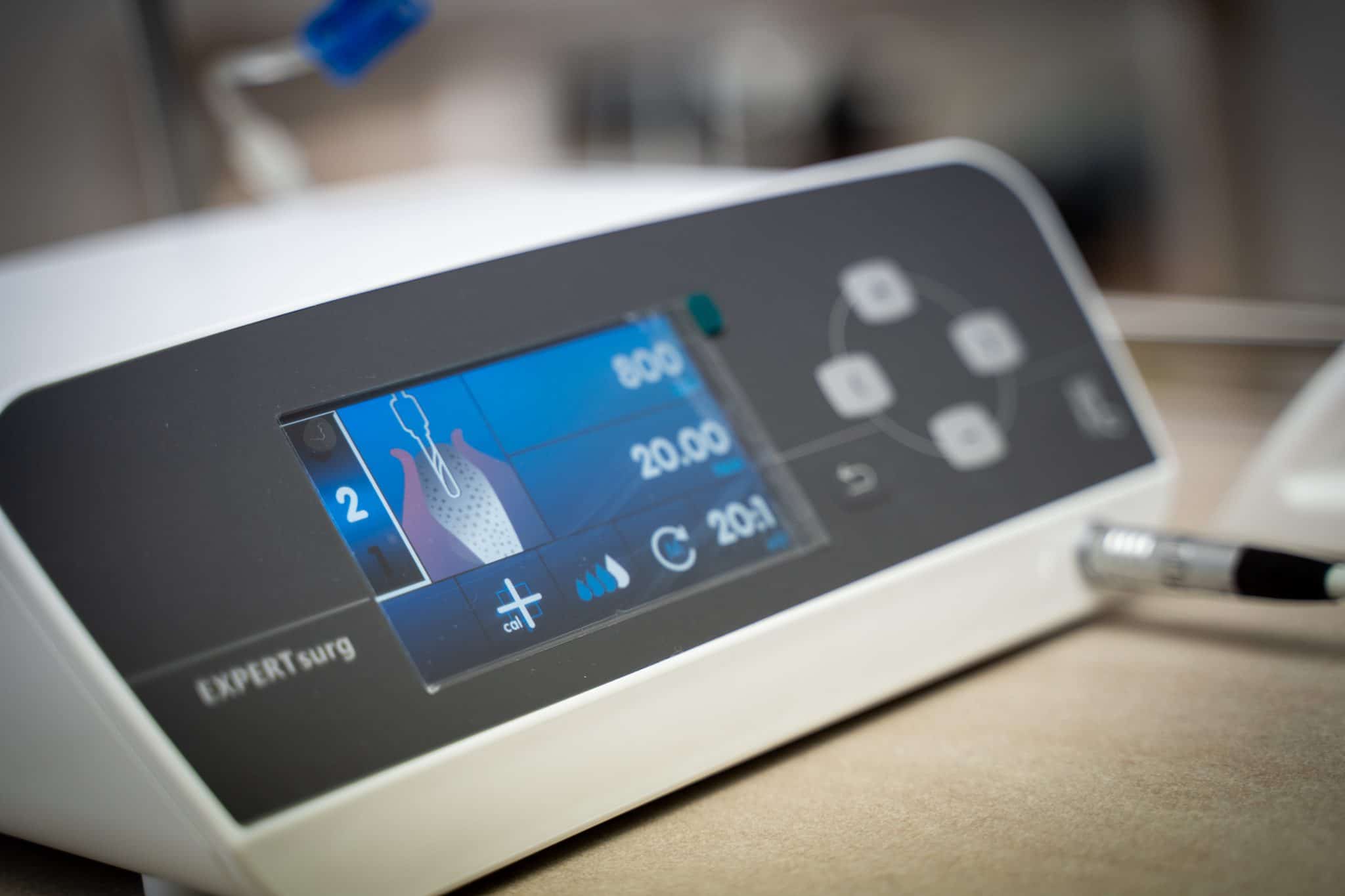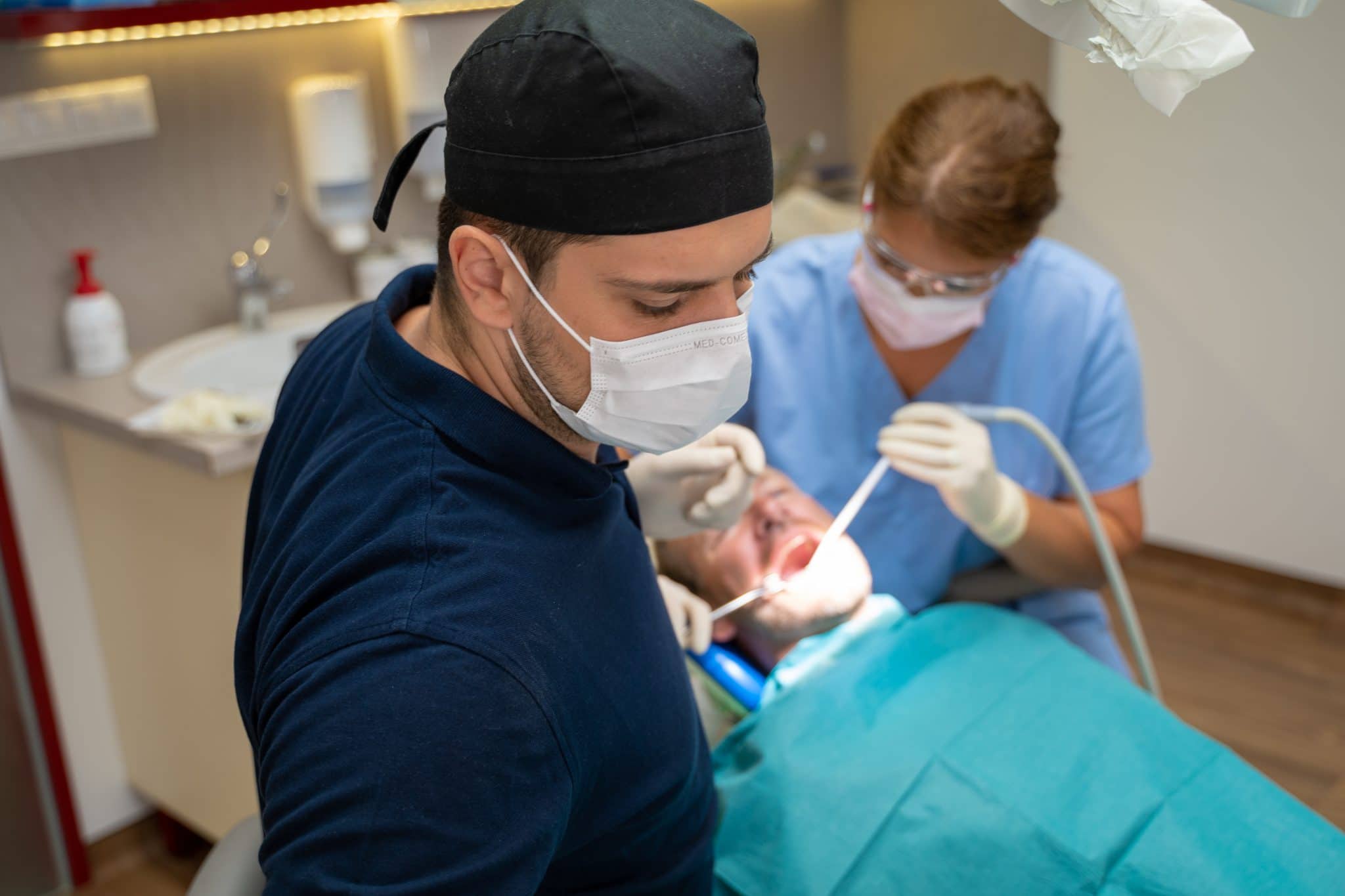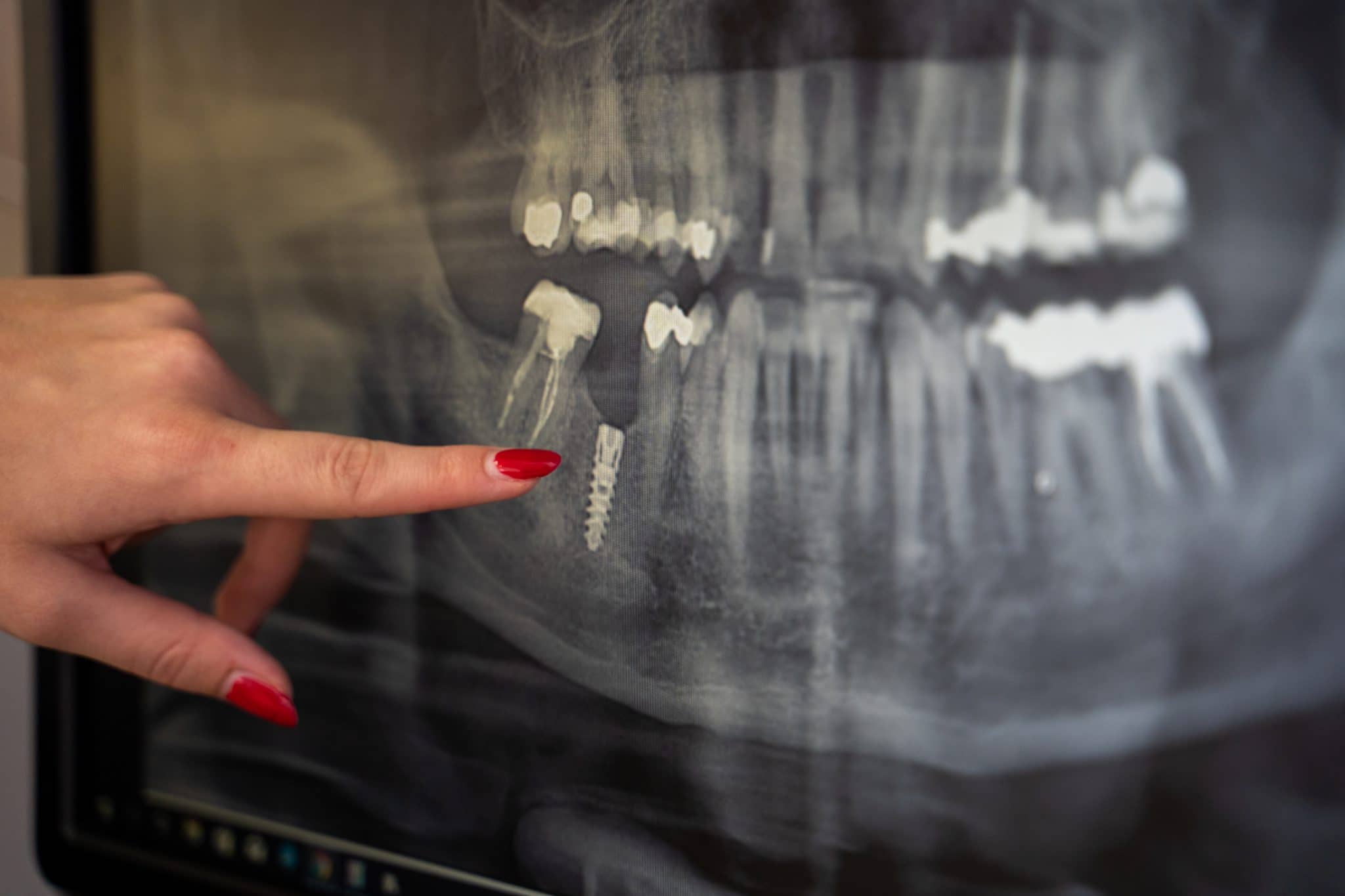The 8 most frequently asked questions about dental implants
1. What is a dental implant?
A dental implant is a surgical component that serve as an artificial root, a screw, usually made of titanium, that is placed levelling with the bone or 1-2 mm deeper. The average length of the implants is 8-14 mm, the diameter is 3-5 mm (there are also smaller so-called mini-implants, which are used to improve the stability of dentures). In case of a regular implant various elements and abutments are inserted into the implant – usually with the help of smaller screws (screw in a screw).
Aesthetic crowns or other prostheses can then be made on the abutments. Implants can be used to replace one or more teeth or entire dental arches. Accordingly, we can speak of fixed or removable dentures. Even a full removable denture can be made much more stable with up to two implants. Generically speaking, it is true that the more implants we insert, the higher stability we can achieve for the restauration.
Tooth loss can occur due to inflammation, trauma, caries, or periodontal disease. Implants, in almost all cases, provide a suitable alternative to replace missing teeth. The implant is inserted directly into the jawbone and a crown, bridge or denture can be attached to it.
Dental implantation has undergone rapid development over the past few decades, and today around 99% of the treatments are successful. Implantation has now become a completely routine procedure. It usually takes place under local anaesthesia, but conscious sedation or anaesthesia are also possible alternatives.
a, what are the key functions of an implant?
With an adequate bone volume, we can substitute the missing tooth or teeth with a dental implant.
Tooth loss can cause a number of aesthetic and functional problems.
Missing teeth can make the person feel very much reserved, and can also lead to some mental disorders.
Additionally, the loss of function results in numerous oral and general health problems; Due to the decrease in the chewing function, the patient cannot chew the food properly, thus he has to swallow it in larger pieces. This leads to digestive problems, stomach and oesophageal complaints, and damage to the entire intestinal tract due to improperly chewed and thus improperly digested food. In most severe cases, the loss of chewing can even lead to malnutrition.
Teeth surrounding the missing tooth tend to bend in the direction of the deficit, they are no longer axially loaded. In the long run the bone, their supporting structure, breaks down. The lack of teeth that is neglected and not replaced for many years, can lead to the weakening and eventually loss of the surrounding teeth as well.
Due to the loss of the teeth, the remaining teeth have an increased load and chewing force, which is also detrimental to the supporting structure of the tooth, the periodontium.
Consequently, is it of paramount importance to replace the missing tooth within a maximum of half a year after tooth loss. Over the years, the bone stock continues to lose its volume as it is not exposed to the load from chewing, which load is an extremely important for bone cells to regenerate.
It is extremely important to replace our missing teeth as soon as possible, not only for aesthetic but also for functional reasons. The most ideal way to do this is with a dental implant.
b, Benefits
-
The missing tooth or teeth can be replaced without shaving off from the surrounding and intact teeth.
-
Implants can be used to replace a missing tooth, as well as provide perfect stability for a denture or bridge attached to them. They can be used if the patient is completely toothless.
-
Implants can significantly improve the quality of life of patients who have been completely toothless and have a long history of using dentures
-
They also improve the stability of dentures.
-
Unlike full dentures, dentures supported by implants do not have a palatal extension, consequently eating, speaking and laughing are no longer a problem.
c, Disadvantages
-
Implants is relatively expensive compared to traditional dentures.
-
Recovery time is slower after implantation (8-24 weeks till the final restoration).
-
If the patient does not have enough bone available, bone replacement might be necessary.
-
Implantation cannot be performed in the event of certain diseases, mainly those that result in immunodeficiency.
2. Dental implants procedure
a, planning
During the first appointment we gather information so that we can provide the best solution for our patient. We examine the health status and assess the potential risk factors (e.g., smoking, grinding of teeth, diabetes, etc.). We discuss what our patient can expect from the treatment and the possibilities.
The examination covers in detail the condition of the teeth and gums, how the patient bites, how far he/she can open his/her mouth, what his/her smile line is, and so on. Additionally, a special three-dimensional dental CT (CBCT) is made, which can be used to diagnose the condition of the jawbones, the volume and quality of bone tissue, certain nerves, the anatomy of the paranasal sinuses, and so on.
We also usually take photos for more accurate design. In many cases, we also take an impression (digital or traditional). This is followed by careful planning based on the information gathered, much of which takes place digitally.
Our goal is to give our patient the best treatment plan in every respect, tailored to the needs of the individual. Not only do we replace one tooth or more teeth, but we also restore the original anatomy that leads to a perfect aesthetic and functional result.
b, the actual procedure
It is important not to arrive on an empty stomach for surgery, as numbness will not allow eating for 3-4 hours post-surgery. The usual medications should be taken in the same way. If you are taking an anticoagulant, it is important to consult your doctor before the procedure about the possible suspension or replacement of the medication.
Prior to and after surgery you should maintain a proper oral hygiene and avoid smoking for a minimum of 2-3 days.
The treatment usually happens under local anaesthesia, but it is also possible to opt for conscious sedation or even full anaesthesia. The latter two methods are used primarily with patients who are extremely afraid of dental interventions. Both have their drawbacks.
The bed for the implant is prepared by a series of drillings, after which the artificial root is inserted. When no complications occur, the procedure can be performed in up to 15 minutes, while in more complicated cases the procedure can take longer
c, what to do and avoid post-surgery?
Soft food is recommended after oral surgery. If only one side has been operated on, it is recommended to chew on the opposite side. It is advised to avoid drinking milk, dairy products, hot food / beverages and alcohol. It is recommended to eat a lot of vegetables and lighter foods (soups, vegetables, white meats). Smoking is strictly forbidden! After a meal, careful but very thorough cleaning of the teeth and the surgical area, as well as rinsing the mouth with antiseptic mouthwash (Curasept, Corsodyl) are of paramount importance.
In some cases, dental implantation can be performed at the same time as the tooth extraction. In this case, the removed tooth is immediately substituted with the implant so that the patient does not have to suffer more surgical interventions. Another advantage of immediate implantation is that both soft and hard tissues can be better preserved in the area.
d, when can the restoration be made on theimplant?
The achieved stability and various other factors determine what happens next, when the implant can be loaded. In exceptional cases an immediate load with a crown /bridge on the day of surgery or in the following days is also optional.
Traditionally, however, a healing time of 2-3 months (Straumann implants are available with a special hydrophilic surface (SLActive®) that speeds up ossification, so up to 6-8 weeks can be enough to make a final replacement) follows.
e, how to maintain a healthy implant?
It is very important to properly clean the implants and the surrounding tissues, as well as the dentures made on the implants. Not doing so, will result in inflammation around the implant, which may even cause the loss of it.
Special oral hygiene tools are needed to clean the implant prostheses: special dental floss, interdental brushes, etc.
Furthermore, dentures must be regularly checked and treated. If we use screw-retained restorations (which is the method almost exclusively used at our dental clinic) that have several advantages over cemented ones, it is worth removing them and checking the implants time to time. Cleaning the replacement, retightening or replacing the screws is also advised.
Regular check-ups are advised to be performed every six months.
f, does the treatment hurt?
Pain may occur post-surgery, depending on the nature of the procedure and individual circumstances. This can be treated properly by taking painkillers and cooling the area with an ice bag. In many cases, it is necessary to perform a more extensive surgery, in other cases, even without incision, implants can be inserted using a digitally designed template. In the latter case, there are far fewer complaints. Many patients do not have any pain post-surgery.
In general, complaints are most intense on the day of surgery and 2-3 days thereafter. Postoperative swelling can take place on the second day after surgery. It is very important to attend post-operative examinations, suture removal (usually 7-10 days, 2-3 weeks in case of bone replacement) and to inform the doctor if you notice any unusual things (e.g., bleeding, discharge of bone replacement material through the nose).
g, dental implantation step by step
-
Implantation must always be preceded by careful planning. This includes oral examination and the analysis of the CT scan during the personal consultation. Based on these, the oral surgeon can provide you with an accurate treatment plan.
-
Dental implantation is a routine procedure that takes place under local anaesthesia (of course, conscious sedation / full anaesthesia is also possible if required).
During the operation, the implant is inserted in the jawbone – first a “hole” is made by drilling in the bone called the “implant bed”. The implant is screwed into this bed and the gums are closed with sutures over the implant.
-
After 7-10 days, the seams are removed.
-
After the healing period, an impression is taken so that our dental technician can prepare the final restoration.
-
The final crown/bridge is completed in a few days and fixed on the implant.
-
Regular check-ups are extremely important to assess the condition of the implants and the surrounding bone and gums, as well as the denture.
3. How can one missing tooth be replaced?
There are several ways to replace a single missing tooth.
a, Replacement with removable denture
This takes a few days; the dentist will take an impression and then the dental technician will make the removable prosthesis. The procedure is fast and cost effective but wearing them usually involves some discomfort to the patient because the lack of stability and can damage the adjacent teeth.
b, replacement with a bridge
c, replacement with using implants
During implantation we insert a sterile titanium root into the jawbone on which a dental crown is placed. The biggest advantage of this procedure is that in this case we do not need to shave off intact dental material from the surrounding teeth, the missing tooth can be substituted with the insertion the new implant. I most cases, the intervention is followed by a few months of healing period during which time the implant fully integrated with the bone. In this case, tooth substitution takes longer than with a bridge.
In an ideal case, we have the possibility for immediate loading, during which tooth replacement takes place simultaneously with implantation.
With the improvements in digital dentistry, we are able to design not only the ideal implant-position, but also the temporary /permanent restoration. These can be manufactured before the surgery and they can be fixed on the implant right after its insertion.
Types of abutments on implants
Abutments are special parts that can be screwed on the implant to connect the implant with the restoration. The design and quality of these parts are of paramount importance, since they provide the connection between the implant and the restoration, and they serve as the basis of it. They can be made of different materials, but mostly they are available in titanium and zirconium. The advantage of zirconium is that its white colour is very aesthetical and the gums adjust to it better too.
Temporary abutments are available for temporary tooth replacements.
Removable dentures are fixed on the implant with special parts e.g., with locators, bars to keep them at place.
Crowns and bridges can be fixed to the implant by screwing or with special cement on top of the abutments.
When making cementable restorations the implant abutment is prepared by the dental technician and screwed into the implant, and then the finished restoration is cemented to it with a special adhesive cement. Its disadvantage is that when using permanent adhesive cement, the denture cannot be removed (only by cutting through the crown). If you later have a problem with the crown or the implant or the tissues around the implant, the only solution is to remove the prosthesis and make it again. Another disadvantage is that the adhesive cement used for the fixation can flow under the gum during the application of the crown / bridge and in many cases cannot be removed completely with the greatest effort, thus causing irritation and inflammation of the tissues around the implant. The advantage of them, however, is that they are much cost efficient and can be used even in case of extremely large angular deviations of the implant axis.
The biggest advantage of screw retained abutments is that they can be removed. After tightening, the screw hole is closed with sealant appropriately. This filling material can be removed at any time later, the screw or screws can be loosened (for repair, check-up, cleaning). Of course, in this case, we do not have to worry about any adhesive cement possibly going under the gums.
The disadvantage of the screw retained abutments is that they are more expensive than the cementable versions.
4. is it possible that the body does not adjust to the implant?
The success rate of implantation is over 99%, which is an excellent rate, but unfortunately not 100%. We practically do not have to worry about allergies, but in some cases the implant may not integrate to the bone. This can happen due to many reasons; excessive load on the implant, the patient has already used his denture although advised otherwise, infections, smoking etc. There are common diseases for which implantation is contraindicated or can only be performed with extreme caution. These include untreated diabetes or diseases that result in various immunodeficiency conditions ( HIV, leukaemia)
Unfortunately, there are also very rare cases where the cause of implant loss cannot be identified. Losing an implant does not mean that the procedure cannot be repeated successfully. It is usually necessary to wait a few months and re-plan the procedure based on another radiology examination. The most common factors that risk successful implantation are: inadequate oral hygiene, smoking, disrespecting instructions, diabetes, and immune system disease. In addition, heavy smoking and poor oral hygiene are also factors that greatly reduce the chances of successful implantation. Implantation is now 99% successful.
Get an appointment now!5. If more teeth are to be replaced, will the dental implant or bridge provide a better solution?
As discussed above, both solutions have their advantages and disadvantages. It is important to note that with proper professionalism both solutions work well in the long run.
The pros and cons of a dental implant:
The great advantage of a dental implant is that it is not necessary to remove your own dental material to make up for the missing tooth, the tooth can be restored with a crown made for the implant. It provides an aesthetically perfect result, and even a professional eye will not tell you that a well-made implant crown is not natural tooth. Implantation can only be performed if a sufficient amount of bone is available.
Thanks to the modern bone regenerative methods available today, we can always “build” a sufficient bone structure for the implant. The disadvantage of dental implants is that they are relatively more expensive than traditional bridge replacements, especially when bone substitution is also needed. In case of bone substitution, the healing time is also longer.
The pros and cons of dental bridges:
Its advantage over implantation is that it is much faster and cost efficient.
Perfect aesthetic and functional results can be achieved with a dental bridge, especially with the use of today’s modern, metal-free crowns made with 3D CAD / CAM process.
The disadvantage of dental bridges is that the removal of dental material is necessary. A well-made dental bridge with proper oral hygiene can provide a good solution for many years and decades to make up for missing teeth.
6. Is it possible to have a dental implant right after tooth extraction?
For this procedure there are 3 possibilities:
- Immediate: in an optimal case the implant can be inserted right after tooth extractions, but it is essential to have sufficient bone structure, atraumatic tooth extraction and non-inflammatory environment.
- Early: in case of inflammation or soft tissue conditions are not optimal, yet bone structure is sufficient we only need to wait 3-4 weeks for the implantation after tooth extraction. During this healing period the bone tissue does not regenerate , but the inflammation stops and the gums close over the dental socket.
- Late: With the conventional procedure it is advisable to wait at least 3 months, depending on the aera/size of the extracted tooth, for the tooth socket to ossify.
In some cases, we have the possibility for immediate implantation, moreover it is also possible to have a dental crown on the implant right after implant surgery.
Immediate implantation, however, requires in-detail planning and it is not possible to perform with certainty in all situations.
Primarily, we can perform immediate implantation when extracting a tooth with a single root (frontal regions) provided that there is no inflammation of the root area and we have sufficient bone structure.
The goal, of course, is always to reduce the number of interventions and minimalize healing time. Consequently, we opt for immediate implantation in all situations possible.
7. What type of implant should you choose?
There are numerous dental implant manufacturers present in the market, so the choice is not easy. In general, it is worth choosing a product from a manufacturer that has been present in dentistry for a long time and thus has long-term experience with its implants. There is not just one type of good or bad implant, several premium quality implants are available. Price however, should not be the deciding factor.
A high-quality implant inserted accordingly, with proper design and properly prepared prosthesis, provides a solution for many decades. In contrast, a poor-quality implant inserted by non-expert hands or an improper prosthesis made on it can cause serious problems after as little as 1-2 years. (For example, inflammatory processes can develop that can lead to the loss of implants and make subsequent re-implantation impossible.)
There are many types of implants, implant systems. In our dental clinic we use two types of systems (from two manufacturers) with several types of implants available (shape, surface, etc.). Depending on the individual situation we opt for the one that is most suitable.
In general, more expensive, premium-category implants are driven by more scientific research and special development to accommodate less optimal situations (e.g., special surface treatment for faster regeneration).
When no complications are present (healthy patient, sufficient bone structure and quality, thick and firm gums) less expensive implants are completely safe options. We only use high-quality implants! The manufacturer provides a lifetime warranty on all implants we use.
A common question is whether an implant or other metal in the mouth can cause problems at an airport. The answer is a definite “no”!
a, Who should opt for a mini-implant? When is it an option?
Mini implants are used mainly when there is no sufficient amount of bone structure available, thus a conventional implant cannot be used.
When the bone structure is not thick enough even for a narrow implant ( the thickness of the bone should be 6-6,5 mm ), mini implants can be sufficient alternatives. These implants can be inserted when the bone structure reaches around 4,4mm thickness.
It is important to note, however, that they can only be applied when the patient is completely toothless and only with removable dentures. There is a need of 4 mini-implants in the lower jawbone and 6 in the upper to provide stability for the denture.
Mini-implants have retention rings that keep the dentures fixed.
b, Some practical pieces of advice if you are planning to have a dental implant:
- Choose a dental clinic with sufficient professional background for dental implantation.
- Choose and implant from an internationally acknowledged manufacturer with a long history of experience
- Detailed planning is necessary before implant surgery. This includes a CT scan based on which sufficient bone structure can be diagnosed.
- Ideally a screw-retained dental crown is to be used. This might lead to additional costs, but we can avoid residue cement around the implant and under the gums. Additionally, the crown is removable, easy to be repaired and fixed on the implant.
c, When do we speak of an “ideal” implant?
Basically, when we have a healthy patient who has sufficient bone structure and soft tissue (thick and firm gums) there is no “ideal” alternative, as all good-quality implants can be used. It is true, however, that if bone substitution is necessary, we would want to opt for an implant with a thin profile. In cases when the patient has certain diseases ( e.g., diabetes, parodontal disease) that means higher risk for the procedure, we would wan to go for an even higher-quality and more expensive implant.
In our dental clinic we use Straumann implants that are made of special titanium-zirconia alloy (Roxolid®) that is way more resistant than other alternatives, thus they provide a perfect solution even in case of narrow implants.
In addition, certain Straumann implants come with a special hydrophilic surface (SLActive®) that ossifies much faster (final replacement can be done after up to 6 weeks), thus we recommend it in more complicated situations (poor quality bone, bone replacement, diabetes, etc.)..
8. What costs should be considered?
The price of a dental implant is influenced by several factors.
a, Costs of the implant and supplementary materials.
It covers not only the price of the titanium screw that is inserted into the bone, but several supplementary parts too such as the abutment (connecting the implant to the dental crown) and tools needed for the impressions and used in the dental laboratory. Prices can significantly vary depending on which manufacturer we use.
It is advisable to opt for a manufacturer that is internationally acknowledged and its products are used worldwide. This way, any regenerative interventions will be available to you, regardless of where you actually stay.
b, Medical fees
Of course, the medical fee of the specialist is also included in the price of the implantation. It is advisable to choose a specialist who has adequate knowledge and experience in the field of implantation. The price of an implant prosthesis can also vary greatly depending on its quality.
Unfortunately, in most of the countries, the insurer only reimburses the price of implants in certain cases (e.g., germ deficiency, accident, cancer).
FAQ
It is not inevitable, there is always an alternative, let it be a removable replacement or a bridge. Sometimes dental implant are the best solutions. The goal, of course, in all cases is to avoid tooth loss, consequently avoiding implantation.
Implantation is completely painless, usually we use local anaesthesia, but conscious sedation or full anaesthesia is also available. Yet the latter two mean increased risk factors. Using guided surgery the postoperative days can be painless as well.
There is a possibility of minimal post-operative bleeding. With inadequate planning, the surrounding nerves or the sinus can be damaged. To avoid inflammation, we use antiseptic cleaning of the mouth and provide the patient with antibiotic medication prior to surgery.











